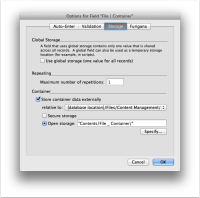Many small businesses take advantage of FileMaker Pro’s ability to host up to 5 clients from a copy of FileMaker Pro, rather than invest in the more pricey FileMaker Server. Recently, I encountered just such a client who wanted to add some document management features to their solution and I wasn’t sure they would be able to do this without investing in FileMaker Server. Since I had already raved up FileMaker Pro 12/13’s greatly improved document management capabilities, I decided to dig in and see if it could still be done using just FileMaker Pro clients.
In my tests, I found that it is, in fact, possible to set the home directory to store PDFs on the ‘server’ (which is running only FileMaker Pro client software). I uploaded a file from another FileMaker Pro client over the network and ‘Eureka!’, FileMaker Pro intelligently stores that PDF in the specified home directory on the designated ‘server’.
Set the Storage on your ‘server’
Here is how to set it up. Create a Container field and go to the Storage tab. Set the location of the storage on the local drive (the ‘server’ machine).
Note: you have to be working on the actual ‘server’ computer to do this, or have remote access to it with something like TeamViewer, Logmein, or VNC. Otherwise, you will be specifying your own computer as the documents host.
Update: 2014-11-05 – The above statement may not be true. Notice in the Path statement in the screenshot below it says “relative to: [database location]. It seems that the system puts the files in the specified location on the host computer.
Select Open Storage or Secure Storage. You will see below what the two options look like.

When you change the file storage options, you will see these two dialogs
Click ‘Transfer’ to go ahead or ‘Cancel’ to back out.

Open Storage: Start uploading files
Here is what the Open Storage directory looks like when a few files have been uploaded.

Secure Storage
Using Secure Storage breaks up the files themselves and obfuscates where the files are stored, making it difficult to reassemble things easily.



 October 15, 2014
October 15, 2014 

Comments are closed.